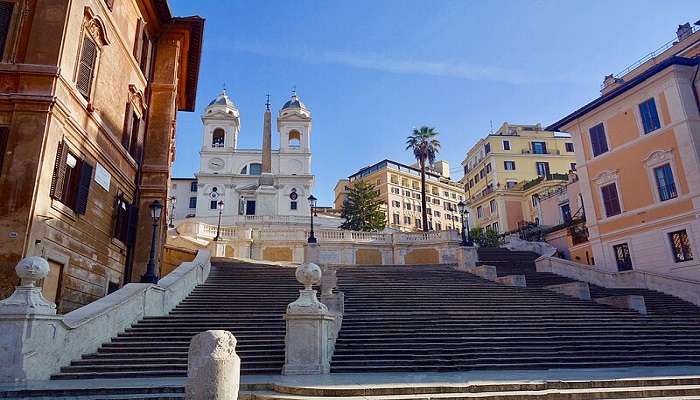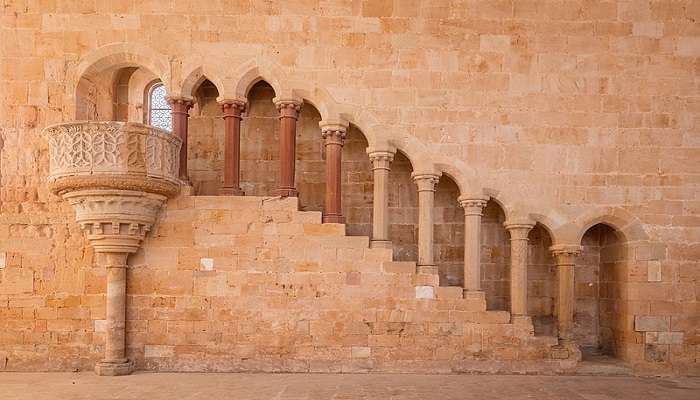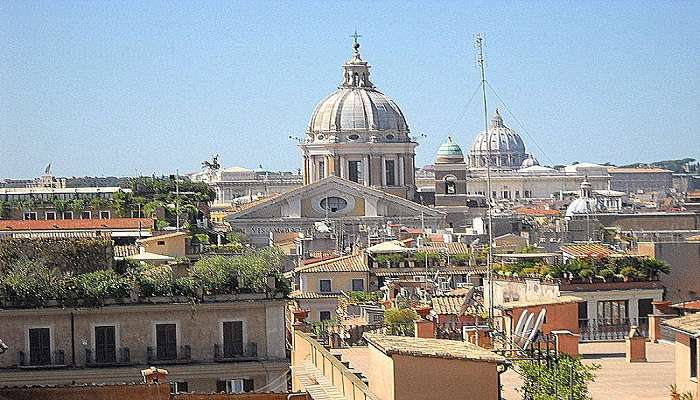Discover The Spanish Steps Which Is An Iconic Landmark In Rome

The Spanish Steps, an iconic landmark in the heart of Rome, have captivated visitors for centuries with their elegant grandeur and rich history. Rising gracefully from Piazza di Spagna to the church of Trinità dei Monti, this Baroque masterpiece is more than just a staircase—it’s a vibrant hub of Roman life and culture. Designed by architects Francesco de Sanctis and Alessandro Specchi in the 18th century, the 135 steps have witnessed countless romantic encounters, artistic inspirations, and unforgettable moments.
About Spanish Steps

The Spanish Steps, known in Italian as the Scalinata di Trinità dei Monti, are a renowned architectural marvel in Rome Italy. This grand staircase ascends a steep incline, connecting two significant plazas: the Piazza di Spagna at the base and the Piazza Trinità dei Monti at the summit. The beautiful Trinità dei Monti church dominates the latter.
The Spanish Steps, which was built with 135 steps, was designed by two architects, namely Francesco de Sanctis and Alessandro Specchi. The steps were commissioned in the Bourbon era of France and are meant to link the Trinità dei Monti church at the top to the Spanish Embassy to the Holy See in the Palazzo Monaldeschi at the bottom.
The Spanish Steps are not only a tourist attraction but also a cultural and historical site. They have been used as a setting for many occasions, movies, and fashion shows, which has contributed to their beauty. The steps are a great place to sit down, take a break, and enjoy the colourful life of Rome.
Also Read: Roman Forum
History Of Spanish Steps

The Spanish Steps are one of the historical places located in Rome and were constructed in the 16th century. At first, Pope Gregory XIII paid attention to the construction of a stairway to the French church, but the construction process began only in the 18th century. Étienne Gueffier, a French diplomat, provided the money for the construction of stairs in 1660, but the construction was delayed by disputes and death.
The steps were designed by Francesco de Sanctis, in a competition held in 1717, while Alessandro Specchi was credited for the design at first. The last design was finished in 1726, and it incorporated the Baroque style of the terraced staircase.
The steps have been restored several times; the latest and most extensive restoration was in 2015-2016 with the help of Bulgari, which cost €1. 5 million. However, the steps have faced some problems with loitering and damage even though they have tried to preserve the condition. In 2019, new rules were implemented to protect them from being damaged: people are no longer allowed to sit or eat on the steps and may be fined for it. Tourism is still an important aspect of this monument; the stairs are also an architectural masterpiece with a history behind them.
Architecture Of Spanish Steps

The Spanish Steps in Rome are one of the best examples of the Baroque architecture. The steps were built between 1723 and 1725 by Francesco de Sanctis and Alessandro Specchi. The stairs have a total of 135 steps, and it links the Piazza di Spagna at the bottom with the Trinità dei Monti church at the top. The design has curves, terraces, and a central ramp, which makes the design look quite striking.
On the bottom of the steps, there is the Fontana della Barcaccia, a fountain in the form of a boat made by Pietro Bernini. The steps of the church are decorated with carvings of the Bourbon Fleur-de-lis and the eagle of Pope Innocent XIII in a bid to show the middle ground between the French and the papacy. The Spanish Steps were a famous meeting point for the Romans and travellers; it was a beautiful area to hang out and admire the beauty of Rome.
Related Post: Vatican Museums
Things To Do Inside The Spanish Steps

The Spanish Steps in Rome are not just a beautiful architectural marvel but also a hub of activity and history. Below are some things you can do while visiting this iconic landmark:
Admire the Architecture: Before proceeding, let’s admire the beauty designed by Francesco de Sanctis. The steps are a typical example of Baroque design and provide a great view of the Piazza di Spagna below.
Visit the Fontana Della Barcaccia: The first stop is the base of the steps where is located the Fontana Della Barcaccia, a Baroque-style fountain created by Pietro Bernini and his son Gian Lorenzo Bernini. The fountain is in the form of a ship that is sinking and this was designed based on a story that a fishing boat got to this place during the flood of the Tiber River.
Explore the Keats-Shelley Memorial House: This house which is situated at the bottom of the Spanish Steps was the last home of the English poet John Keats. Today it is a museum dedicated to Keats and the Romantic Movement and provides a look at the poet’s life and work.
Enjoy the View from Trinità dei Monti Church: At the top of the Spanish Steps is the Trinità dei Monti Church. The church is located on a hill and is a perfect place for taking great pictures of Rome.
Shop at Via dei Condotti: Located only a few hundred meters from the famous Spanish Steps, Via dei Condotti is one of Rome’s premier shopping destinations. Here, it is possible to meet the shops of the latest fashion and the most famous brands.
Relax and People-Watch: It is visited by both the locals and the tourists. Sit down on the steps, take a break watch people and get inspired by the energy of the crowd.
Some Interesting Facts

The Spanish Steps in Rome are a fascinating historical landmark with a rich history and unique features. Here are some interesting facts about them:
- The Spanish Steps feature 135 steps, designed by Francesco de Sanctis and completed in 1725.
- It is a stunning example of baroque architecture and serves as a monumental staircase.
- In Italian, it is known as “La Scalinata di Trinità dei Monti,” named after the church at the top.
- The steps gained international recognition through films like “Roman Holiday” with Audrey Hepburn and Gregory Peck.
- In the 18th and 19th centuries, the steps were a popular meeting place for artists, poets, and the elite.
- At the base of the steps is the Fontana della Barcaccia, a fountain designed by Pietro Bernini.
- In 2015, the luxury brand Bulgari funded a €1.5 million renovation project to restore the steps.
Related Post: Rome Travel The Eternal City
How To Reach?

To reach the Spanish Steps in Rome, Italy, you can follow these directions based on different starting points:
By Air
If you’re arriving by air, you have two main options: The two main airports are the Leonardo da Vinci International Airport located in Fiumicino and the Ciampino Airport. From Fiumicino, one can take the Leonardo Express Train to Termini Station, and the train operates every 30 minutes. To get to the Spanish Steps, take the Metro Line A from Termini station and get off at Spagna station, which is right opposite the Spanish Steps. You can also get a taxi or a car service that you booked earlier to take you to the Spanish Steps. There are some buses and shuttles that link Fiumicino with some parts of Rome, including Termini Station. Buses are available from Ciampino Airport to Termini Station, and from there, one can take the Metro Line A to Spagna Station.
By Rail
For those who prefer to use the train, Termini Station is the biggest and the most important one. To get there, you have to go to Termini Station, take Metro Line A, and get there by alight at Spagna Station. Also, the nearest tram stop to the Spanish steps is Flaminio, which is about 700 meters away.
By Bus
If you wish to travel by bus, there are numerous city buses that can drop you near the Spanish steps. Buses 52, 53, 62, 63, 71, 83, 85, 160, and 492 are available at Tritone/Trevi, which is near the Spanish Steps. The closest stops to the Spanish Steps are Condotti and Trinita dei Monti, which are two of the most popular stops.
You May Also Like To Read: Day Trips From Rome
The Spanish Steps remain an enduring symbol of Rome’s timeless beauty and romantic allure. Whether you’re admiring the cascading flowers, people-watching from the steps, or simply soaking in the vibrant atmosphere, this iconic landmark offers a quintessential Roman experience. Let the Spanish Steps beckon you to the Eternal City as you plan your next adventure. Don’t just dream about standing atop this magnificent staircase—make it a reality. Book your trip to Rome today and immerse yourself in the magic of the Spanish Steps. Your Roman holiday awaits, promising unforgettable moments and cherished memories. Andiamo!
For our editorial codes of conduct and copyright disclaimer, please click here.
Cover Image Credit :Sonse for Wikimedia Commons
Frequently Asked Questions About Spanish Steps
What is special about the Spanish Steps?
The Spanish Steps are a monumental stairway of 135 steps, connecting Piazza di Spagna with the Trinità dei Monti church. They serve as a vibrant gathering spot and are a celebrated example of Rome's exquisite Baroque architecture.
How many Spanish Steps are there?
The Spanish Steps comprise 135 steps, which are beautifully arranged in three distinct terraces. This design symbolises the Holy Trinity, enhancing the steps' cultural and religious significance in Rome's historical landscape.
What is the story behind the Spanish Steps?
Constructed between 1723 and 1725, the Spanish Steps were funded by a bequest from a French diplomat. They serve to connect the Trinità dei Monti church, representing France, with the Spanish Embassy located at Piazza di Spagna.
When should I go to the Spanish Steps?
The best times to visit the are during spring and fall when the weather is pleasant and crowds are smaller. Early mornings or late evenings are ideal for avoiding the peak tourist rush and enjoying a quieter experience.
What is at the bottom of the Spanish Steps?
At the base of the Spanish Steps is Piazza di Spagna, one of Rome's most iconic squares, featuring the Barcaccia Fountain. This Baroque masterpiece, designed by Pietro Bernini, adds to the area's artistic and cultural charm.
People Also Read:
Tourist Places In Rome Things To Do In Rome Villas In Rome

With a passion for exploring and travelling to the roads long forgotten, experience the world through enthralling stories and adventures. Join me as I share my experiences at some of the world’s most popular tourist destinations and quench that pestering curiosity with something exciting!











